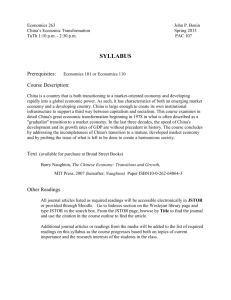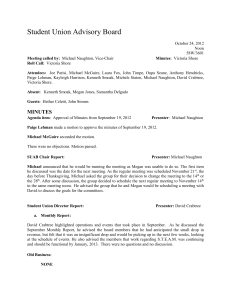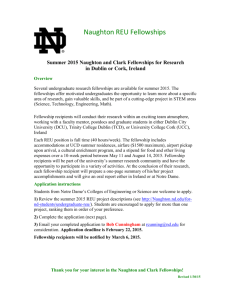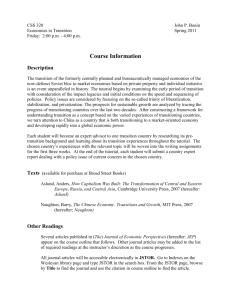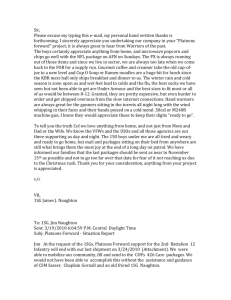Syllabus - WesFiles
advertisement
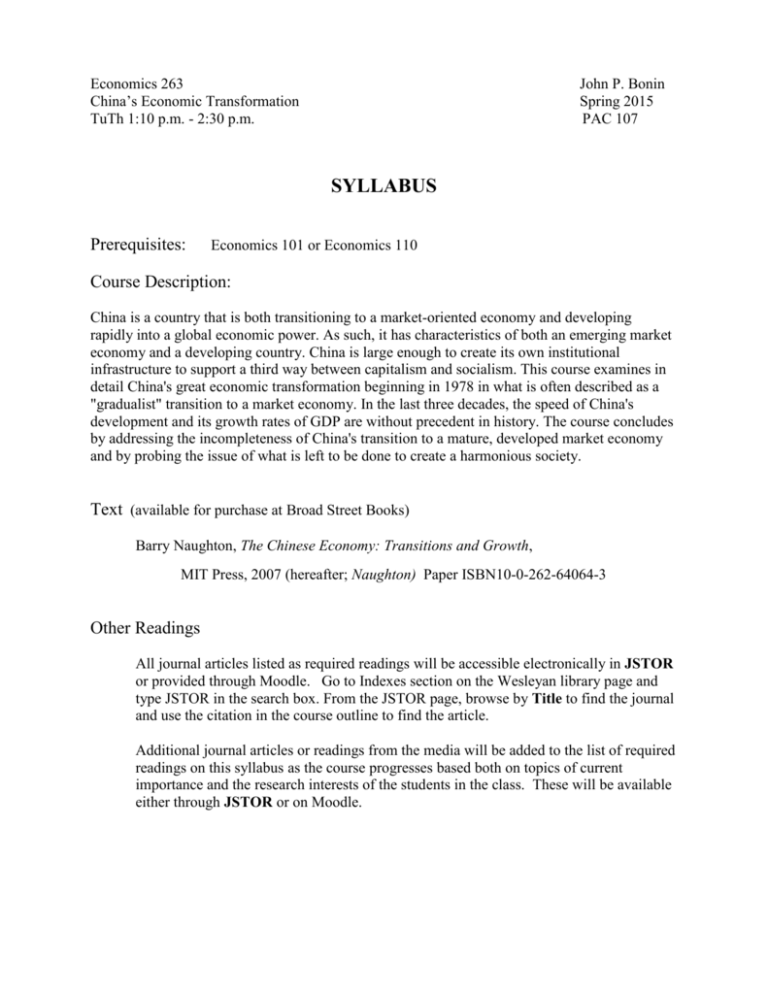
Economics 263 China’s Economic Transformation TuTh 1:10 p.m. - 2:30 p.m. John P. Bonin Spring 2015 PAC 107 SYLLABUS Prerequisites: Economics 101 or Economics 110 Course Description: China is a country that is both transitioning to a market-oriented economy and developing rapidly into a global economic power. As such, it has characteristics of both an emerging market economy and a developing country. China is large enough to create its own institutional infrastructure to support a third way between capitalism and socialism. This course examines in detail China's great economic transformation beginning in 1978 in what is often described as a "gradualist" transition to a market economy. In the last three decades, the speed of China's development and its growth rates of GDP are without precedent in history. The course concludes by addressing the incompleteness of China's transition to a mature, developed market economy and by probing the issue of what is left to be done to create a harmonious society. Text (available for purchase at Broad Street Books) Barry Naughton, The Chinese Economy: Transitions and Growth, MIT Press, 2007 (hereafter; Naughton) Paper ISBN10-0-262-64064-3 Other Readings All journal articles listed as required readings will be accessible electronically in JSTOR or provided through Moodle. Go to Indexes section on the Wesleyan library page and type JSTOR in the search box. From the JSTOR page, browse by Title to find the journal and use the citation in the course outline to find the article. Additional journal articles or readings from the media will be added to the list of required readings on this syllabus as the course progresses based both on topics of current importance and the research interests of the students in the class. These will be available either through JSTOR or on Moodle. 2 Economics 263 COURSE NOTES Readings Students are expected to complete the reading assignments announced at each class meeting before the next class to facilitate informed classroom discussion and to insure a regular work pace. The instructor will follow the timing in the course outline in assigning readings. Assignments Two Writing Assignments: One for Each Module Writing should not be left to the last minute. By writing, we find out what we do not know and, hence, what we need to learn to make crucial connections. In essence, writing should be an equal partner with reading in the learning process. The successful student recognizes this quickly and begins writing while reading the material on the topic. Hence, the prompts for the writing assignments are included in this course outline. By revising what we have written, we tighten and improve the argument. Papers that have not been revised at least once do not present the writer’s best work. Research Project with Timetable Each student will pursue a topic of interest regarding the incompleteness of China’s transition to a mature, developed market economy and a harmonious society. A précis of work in progress is due after the spring break. The final research paper is due at the end of the term. Class time toward the end of the term will be devoted to student presentations based on the research projects. Identification of Topic: March 5 Précis of Work in Progress: March 26 Class Presentation: April 21 – May 5 Final Research Paper: May 13 3 Economics 263 Class Rules Penalties and Rewards Equity dictates that any late work is subject to a grade penalty, namely one full grade per week. In addition, any student who attends class infrequently may be assessed a grade penalty for poor class participation. Extra credit may be given for exceptional class participation, especially during the presentations and class discussions of research topics. Incompletes An incomplete will be granted only for extreme hardship. If granted, an incomplete is subject to a modified grade penalty. University policy requires that all incomplete work must be submitted by the first day of the subsequent semester. When granting an incomplete, this instructor calculates a provisional grade assuming that the work to be completed is evaluated at zero. Consequently, the provisional grade submitted with the incomplete is usually F. This grade becomes a permanent fixture on the transcript of any student who does not complete the work by the prescribed date. The instructor enforces strictly the university policy regarding incompletes. Please do not take unnecessary risk; avoid incompletes! Schedule of Writing Assignments and Grade Percentages Assignment #1 February 26 (30%) Précis of Work in Progress March 26 (10%) Assignment #2 April 16 (30%) Final Research Paper May 13 (30%) Other Information Instructor Office Hours: PAC 305 Wednesday: 1:30 p.m. – 3:00 p.m. Friday: 2:00 p.m. – 4:00 p.m. Contact Information: jbonin@wesleyan.edu or x2353 4 Economics 263 COURSE OUTLINE Module 1: Transition/Development: Gradualism or Procrastination? After the People’s Republic of China was established in 1949, China’s new leadership tried to promote development from the top creating a massive socialist industrial complex and using direct government controls, i.e., the command economy. Mao’s big push industrialization program, known as the Great Leap Forward, generated an economic crisis followed by a period of readjustment but culminated in the chaotic period, known as the Cultural Revolution. In 1978, the new leaders embarked on economic reforms that promoted economic growth rates in GDP and GDP per capita over the next three plus decades that are without precedent in history. The reforms were a mix of economic development strategies and gradualist policies designed to foster the transition from the planned command economy to a more market-oriented economy. In the process, China’s gradualist reforms have been characterized as “dual track” and “growing out of the plan”. Proponents of a gradualist transition from a bureaucratically managed economy to a market economy stress the importance of maintaining political support for reforms by minimizing the costs of change. Opponents stress the need to move quickly lest those elites who stand to lose from the change acquire the ability to stall or completely thwart reforms as in Russia. Deng Xiaoping used the metaphor of crossing a river by stepping from stone to stone to characterize economic reform in China. By considering China’s experience over this time period, insights are gained into the interplay of policies and institutions that support a stable, but transforming, economic system. A: Overview and Legacies (Jan. 22 – Jan. 27) Naughton: Introduction & Chapters 1, 2 & 3 Note: Bold underlined numerals indicate core chapters from Naughton Lin, Justin Yifu Demystifying the Chinese Economy Cambridge University Press 2012: Chapter 4 (Moodle) B. Transition to the Market (Jan. 27 – Feb. 3) Naughton: Chapters 4 & 5 Lin: Chapter 6 (Moodle) Perkins, Dwight “Completing China’s Move to the Market,” Journal of Economic Perspectives (hereafter, JEP), 8:2, (Spring) 1994, pp. 23 - 46. (JSTOR) C. Growth and Structural Change (Feb. 3 – Feb. 10) Naughton: Chapters 6, 7, 8, and 9 5 Economics 263 D. Rural Industrialization: Organizational Reform (Feb. 10 - Feb. 17) Naughton: Chapter 10, 11 & 12 Lin: Chapter 7 (Moodle) Qian, Yingyi “How Reform Worked in China” Chapter 11 in In Search of Prosperity: Analytic Narratives on Economic Growth, Dani Rodrik (ed.) (Moodle) E. Industrial Change: Toward a Modern Economy (Feb. 17 - Feb. 24) Naughton: Chapters 13, 14 & 15 Lin: Chapters 8 and 9 (Moodle) Jefferson, Gary and Rawski, Thomas, “Enterprise Reform in Chinese Industry,” JEP, 8:2, (Spring) 1994, pp. 47 - 70. Writing Assignment#1: China’s Reform Strategy: Growth and Market Development Spurred on by economic reforms beginning in 1978, the speed of China’s development and its growth rates in GDP and GDP per capita over the next three plus decades are without precedent in history. Lin characterizes the growth strategy in China prior to 1978 as comparative advantage-defying (CAD) to distinguish it from comparative advantage-following (CAF). Naughton separates a roughly thirty-year period into two phases of reform using 1992 as the dividing year. Deng restarted economic reform after the Tiananmen Square demonstrations in 1989 when he took his “Southern Tour” to visit the existing Special Enterprise Zones (SEZs). Provide an overview of growth in GDP and identify any differing aggregate trends across the two phases. Contrast and compare the main engines (factors) of China’s rapid growth in the two phases by discussing their impact on overall growth. Would Lin consider the growth strategies in each phase to be CAD or CAF? Why? Naughton characterizes the first phase of economic reform up to 1989 as “reforms without losers” and “growing out of the plan.” How does the changing composition of plan and market during the first phase of the reform relate to Qian’s notion of transitional institutions? Focusing on the transitioning-to-the-market aspects of rural reforms, why does Qian consider TVEs to be a transitional institution? Would Perkins and Qian agree with Naughton’s assessment of the first phase? Why or why not? 6 Economics 263 Naughton provides a more pessimistic characterization of the second phase after 1992 as “reforms with losers.” Rawski and Jefferson conclude their analysis of the first phase of enterprise reforms in China with an optimistic statement concerning China’s ability to harness its potential for further gains without creating intolerable political tensions or social costs. On what do Rawski and Jefferson base their optimistic assessment? Why does Qian consider large state-owned enterprise reform to be a failure rather than a transitional institution? Do you agree with Naughton’s assessment? Why or why not? Expected Length: No more than eight (8) but at least six (6) double-spaced typewritten pages in standard font of normal size, e.g., this assignment is typed in Times New Roman, size 12, with standard page margins Due Date: February 26 Note: Your paper should be an economic analysis of the issues identified in the prompts but you must integrate the material into a cohesive paper. You should NOT answer the prompts as if they are exam questions. However, you should engage sufficiently the material in the prompts. Writing Tips Hope these help! (see final page for more advice) 1. Your paper should begin with a strong introductory paragraph that you write at the end of your revisions! This paragraph frames your paper and establishes an overarching theme. By the end of the first paragraph, the reader should be able to identify the main (integrative) theme of the paper. 2. Organize the order of the paragraphs to develop and support your integrative theme. 3. Make sure that each paragraph has integrity in that it makes a clear point and concludes by supporting that point. 4. Make sure that you use the information from the readings to provide the necessary evidence (data) to support each point by making the appropriate connections and links. 5. Do NOT simply summarize (or reproduce in catalogue format) the information from the readings. Rather present your own perspective on the material using the information therein to make connections and links. 6. Do NOT write unsupported generalizations. These do not contribute to the development of your main theme nor do they suffice to engage the material properly. 7. Do NOT simply reproduce conclusions from the readings and attribute them in support of a point. If you agree with a point made in the readings, develop your own argument to support it. Explain why you find the point compelling. 7 Economics 263 Précis of Work in Progress Due Date: March 26 A research prospectus and précis of work in progress contains three essential components. 1. The motivation for the research and a statement of the research question. A clear statement of the focus of your research with a specification of the research question should be provided. 2. A statement of the research approach to be taken and the progress made should be provided. The following questions may provide useful prompts for presenting and developing the research approach. However, they are not intended to be a list of exam questions to be answered individually. Please use judiciously! How do you intend to answer the research question? What evidence will you seek? What supportive argumentation will you use? What are your anticipated results? How do you expect to support any resulting policy conclusions? In addition, a brief statement of the work you have accomplished to date should be included. This statement should identify any difficulties that you foresee in dealing with your research question so that the instructor can provide help in a timely manner. 3. An annotated bibliography. This consists of a list of sources that you have found to date for your research project. Each citation is accompanied by two or three sentences that link the material in the source directly to your research question. You must explain why you think that this source will be useful in dealing with your research question. The references should be arranged alphabetically by the author’s last name. Be sure to include full information in your citations. See the references at the end of the chapters in Naughton for examples of proper formats for citations. Expected Length: Sections 1 and 2 combined should be at least two (2) but no more than three (3) pages. Section 3 should be at least one (1) but no more than two (2) pages. 8 Economics 263 Module 2: China Becoming a Global Economic Power? (Feb. 26 – April 14) Naughton: Chapters 16, 17, 18, 19 & 20 Brandt, Loren, Ma, Debin, and Rawski, Thomas “From Divergence to Convergence: Reevaluating the History Behind China’s Economic Boom” Journal of Economic Literature (forthcoming) – specified section(s) (Moodle) Yusuf, Shahid “China’s Macroeconomic Performance and Management During Transition,” JEP, 8:2, (Spring) 1994, pp. 71 - 92. Lin: Chapter 12 and Appendix (Moodle) Naughton, Barry “China’s Economic Policy Today: The New State Activism” Eurasian Geography and Economics Vol. 52, No. 3 2011 NB: The instructor will assign additional readings tailored to the interests of the class as expressed in the topics students choose for their research projects 9 Economics 263 Writing Assignment #2: China as a Global Economic Power: Unfinished Business ALERT! Preliminary: may be revised depending on material added As an emerging economic power, China has opened up gradually to the global economy culminating in its accession to the WTO in December 2001. Intertwined are the developments of China’s international economic relations with the accompanying evolution of its domestic macroeconomy and financial system during the period characterized by Naughton as the second phase of economic reforms (1992 – 2005). Discuss fully the interrelationships among economic policies in these three areas. Be sure to include relevant data from Naughton and any other assigned readings. Lin claims that distortions remain and that China’s transition is incomplete. Brandt and his coauthors conclude their broad ranging treatise by discussing “unfinished business” or what is left to be done. In his recent article, Naughton argues that China responded to the recent financial crisis by turning to a more state-directed economy. To develop the idea of an incomplete transition, relate the outcomes from policies undertaken in the first phase to subsequent enterprise reform policies introduced in the second phase. Establish the sense in which the second phase of enterprise reforms leaves incomplete China’s transition. What are the other major aspects of the Chinese economy that continue to impede the completion of its transition to a market economy? Why do Brandt and his colleagues claim that the economy is deeply flawed? Would Naughton agree? On which side of the debate referred to in the last paragraph of Naughton’s article would Brandt and his colleagues fall? What remains to be done to put the Chinese economy onto a sustainable path to an unflawed market economy and a global economic power? Expected Length: No more than eight (8) but at least six (6) double-spaced typewritten pages in standard font of normal size, e.g., this assignment is typed in Times New Roman, size 12, with standard page margins. Due Date: April 16 Presentations and Discussions (April 21 – May 5) - To be Completed - Final Research Paper Due on May 13 10 Economics 263 WRITING TIPS 1. Every paper should have an integrative theme in the introductory paragraph. The integrative theme specifies the position that will be taken and defended; hence, it serves as a selection tool to guide the writer in determining what to include in the final version of the paper. Write no final paper without an integrative theme. 2. The easiest way to develop a strong argument is to force differences. Sometimes this can be done effectively in a point-counterpoint framework. Evidence and well-structured logical arguments are the foundations of good analytical writing. Make sure that your paper deals with the topic in sufficient depth. 3. Each paragraph must have its own integrity and be brought to closure. A paragraph is NOT a laundry list of assertions. Nor should a point-counterpoint development be left unresolved and drift into oblivion. You should be able to state the basic point of each paragraph using a four-word phrase. Each paragraph must bring the point to closure. CONCLUDE a paragraph; don’t simply end it. 4. A paper is like an hourglass. The introduction begins from a broad perspective to motivate the paper and narrows by stating the integrative theme. The body of the paper develops fully and solidly the position in the integrative theme. Paragraphs make individual points; they are arranged sequentially to support and defend as strongly as possible the position taken. The conclusion does not simply restate the position or recapitulate what has been done. Rather the conclusion should convince the reader that the writer has supported the position compellingly. Convince the reader of the strength of your analysis in the conclusion. FROST YOUR CAKE!
